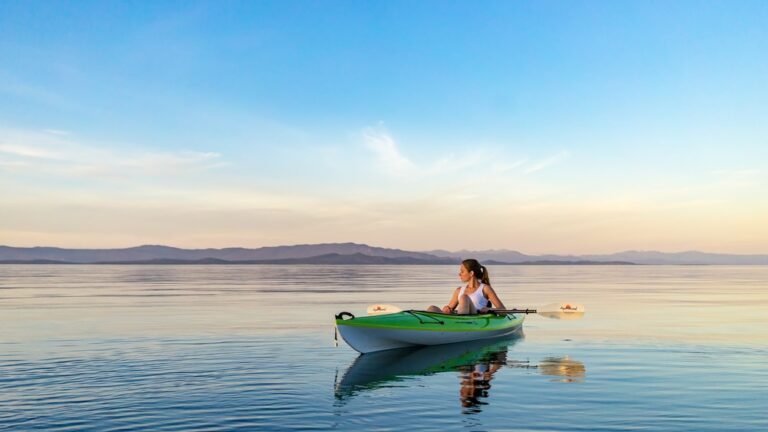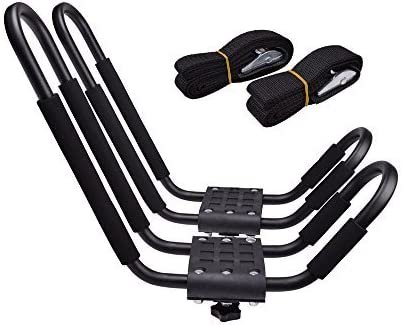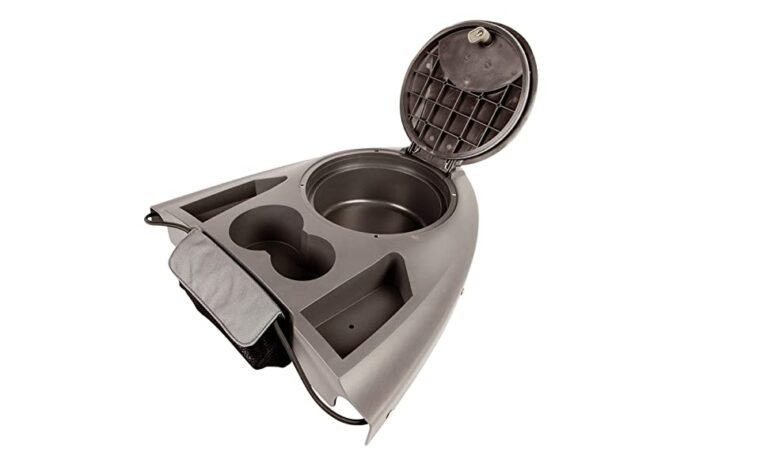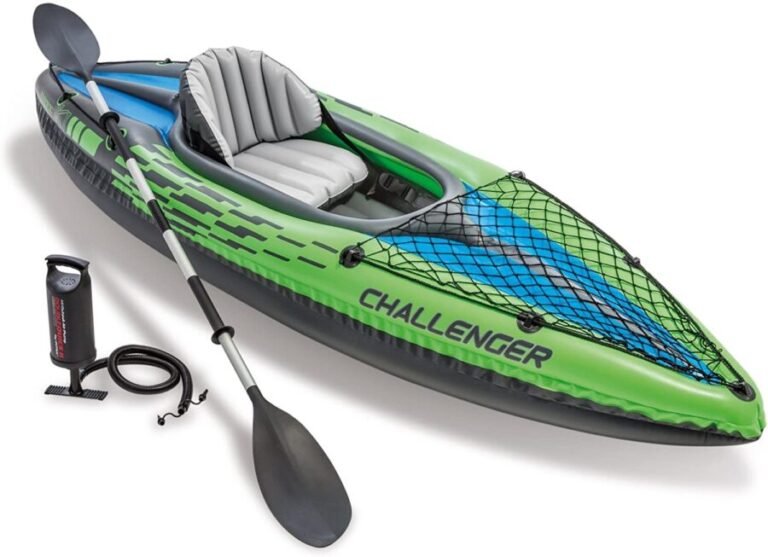Sind aufblasbare Kajaks sicher?
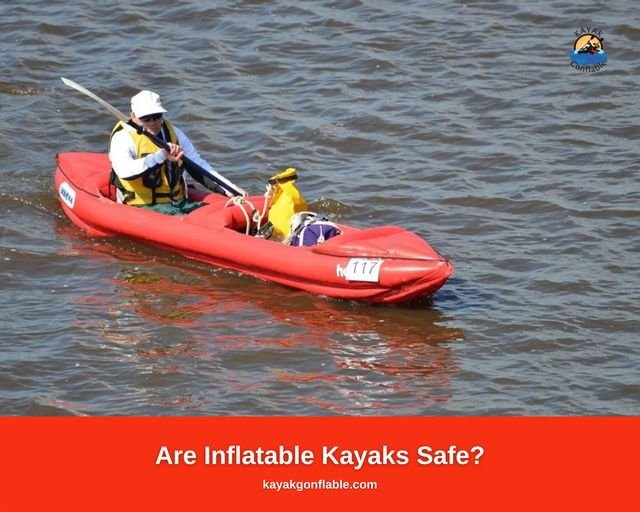
Wie sicher sind aufblasbare Kajaks?
Wenn wir hören, dass etwas aufblasbar ist, kommt uns sofort in den Sinn, dass es weich, aufgeblasen und leicht platzbar ist. Und doch haben wir aufblasbare Kajaks.
Das erste Mal, dass ich davon gehört habe aufblasbare KajaksDas erste, was mir in den Sinn kam, war: „Das kann doch sicher nicht sicher sein.“ Viele Menschen haben ähnliche Bedenken hinsichtlich der Sicherheit eines aufblasbares Kajak und ob es genauso gut funktionieren kann wie ein Hartschalenkajak.
Wenn Sie dies auch erlebt haben, sind Sie hier richtig, denn dieser Artikel wird den Missverständnissen darüber ein Ende bereiten aufblasbare Kajaks.
Was ist ein aufblasbares Kajak?
Simply, an aufblasbares Kajak is a kayak that needs to be pumped up with air. If you want a more advanced definition then it’s a multi-layered PVC (polyvinyl chloride) boat with meticulously built air chambers to give buoyancy and allow them to float on water.
Es verfügt möglicherweise über andere Funktionen und Zubehörteile, die nicht aufblasbar sind, wie zum Beispiel die Sitze oder die Fußstütze, aber solange es aufgeblasen werden muss, handelt es sich um ein aufblasbares Kajak. Es gibt verschiedene Arten von Schlauchbooten Kajaks hergestellt passend zu Ihren persönlichen Polsterungsstilbedürfnissen und -vorlieben.
Ein selbstlenzendes Kajak ist für schnell fließende Gewässer konzipiert. Darüber hinaus verfügt es über Abflusslöcher, um zu verhindern, dass Ihr Kajak mit Wasser überflutet wird. Das bedeutet allerdings, dass Sie damit rechnen müssen, dass Ihr Sitz nass wird.
Ein Sitzkajak mit niedrigem Schwerpunkt bietet große Stabilität und ähnelt im Design stark dem Hartschalenkajak. Wie ein Hartschalenkajak verfügt auch das Sitzkajak über ein Cockpit, in dem man sitzen kann.
Es bietet Platz im Rumpf für die Aufbewahrung von Ausrüstung und Vorräten und hat den zusätzlichen Vorteil, dass es bei kaltem Wetter wärmer ist.
Ein Sitzkajak ist perfekt für unerfahrene Kajakfahrer und Kinder, da es sehr einfach zu bedienen und zu beherrschen ist. Sein Deck ist beträchtlich groß und offen.
Diese Art von aufblasbarem Kajak wird Sit-on-Kajak genannt, da Ihre Beine nicht wie bei herkömmlichen Sit-in-Kajaks in einem Cockpit untergebracht sind, sondern auf dem Dach dieser Kajaks sitzen.
Tandem Kajaks sind für Kajakfahrer, die gerne in Begleitung paddeln. Es handelt sich um 2-Personen-Kajaks, die sich perfekt für Paare eignen, die etwas Zeit für sich alleine in der Natur verbringen möchten, oder für Freunde, die auf der Suche nach ihrem nächsten Abenteuer sind.
Sie sind mit zwei Sitzen ausgestattet und verfügen zusätzlich über eine zusätzliche Länge, die das Kajak stabiler macht.
Vorteile eines aufblasbaren Kajaks
Neben dem großen Vorteil, dass ein aufblasbares Kajak günstiger ist als ein Hartschalenkajak, gibt es noch mehrere weitere Vorteile, die Sie bei der Verwendung genießen werden.
Portabilität: Einer der größten Vorteile, die ein aufblasbares Kajak gegenüber einem Hartschalenkajak hat, ist die Tatsache, dass es so leicht zu tragen und zu bewegen ist.
Ein aufblasbares Kajak ist im Allgemeinen viel leichter als ein Hartschalenkajak. Sobald alle Fächer entleert sind, können sie aufgerollt und fest in einer Transporttasche zusammengefaltet werden, die Sie überallhin mitnehmen können.
Dies macht es zur perfekten Option für Urlaubsreisen an Orte, an denen es möglicherweise schwierig ist, Kajaks zu mieten, da aufblasbare Kajaks entweder verschifft oder als einfaches Gepäck mitgenommen werden können.
Die Tatsache, dass es auch in einer Transporttasche aufbewahrt werden kann, macht es viel lagerfreundlicher, sodass Sie es bei Nichtgebrauch einfach in einen Schrank oder den Keller werfen können.
Stabilität und Steifigkeit: Aufblasbare Kajaks sind unglaublich stabil, stark und steif. Stellen Sie jedoch sicher, dass sie vor dem Gebrauch gut aufgeblasen sind. Wenn nicht, fällt es Ihnen möglicherweise schwer, im Kajak über Wasser zu bleiben.
Um sicherzustellen, dass sie auf dem Wasser äußerst stabil bleiben, sind die meisten aufblasbaren Kajaks mit einem Metallrahmen oder mit dünnen aufgeblasenen Segmenten ausgestattet, die als Stangen fungieren. Beide erfüllen die gleiche Funktion als Stabilisatoren im Kajak.
Wenn Sie jedoch vorhaben, ein aufblasbares Kajak auf dem Meer oder zum Wildwasserkajakfahren zu verwenden, ist es ratsam, Kajaks zu verwenden, die speziell für diesen Zweck entwickelt wurden.
Haltbarkeit: Wie bereits erwähnt besteht ein aufblasbares Kajak aus mehreren Schichten PVC, was es sehr langlebig macht. Das zur Herstellung dieser Kajaks verwendete PVC ist normalerweise beschichtet, was sie sehr robust macht.
Einige Kajaks wurden aus noch stärkeren Materialien wie Hypalon hergestellt, wodurch sie länger halten als ein aufblasbares PVC-Kajak.
Die meisten aufblasbaren Kajaks halten im Durchschnitt etwa 7 bis 10 Jahre, und diese Lebensdauer kann sich bei richtiger Pflege und Wartung sogar auf 20 Jahre verdoppeln.
Wenn Sie also wirklich das Beste aus Ihrem Kajak herausholen möchten, müssen Sie es gut pflegen.
Eigener Auftrieb: Das Beste an einem aufblasbaren Kajak ist die Tatsache, dass es aufgrund seiner mehreren luftgefüllten Kammern einen unglaublichen Auftrieb hat. Das heißt, egal was passiert, sie werden nicht untergehen.
Selbst wenn sie mit Wasser gefüllt sind, sind sie so schwimmfähig, dass sie über Wasser bleiben, und da die meisten aufblasbaren Kajaks selbstlenzend sind, läuft das Wasser sofort ab.
Und aufgrund ihres breiteren Designs sind sie unglaublich schwer zu kentern. Aufblasbare Kajaks haben außerdem eine höhere Tragfähigkeit und eignen sich daher perfekt zum Angeln.
Anfängerfreundlich: Ein aufblasbares Kajak ist nicht nur perfekt für Kinder, sondern auch die erste Wahl Kajak für Anfänger oder unerfahrene Kajakfahrer.
Wenn Sie jemand ohne Erfahrung sind, wäre ein aufblasbares Kajak ein guter Ausgangspunkt. Abgesehen davon, dass es leicht, sehr stabil und langlebig ist und nicht untergeht, müssen Sie für den Kauf eines solchen Geräts auch nicht viel Geld ausgeben.
Ich meine... was gibt es da nicht zu lieben?
Sind aufblasbare Kajaks sicher?
Eines der größten Bedenken, die Menschen bei der Verwendung eines haben Bei einem aufblasbaren Kajak geht es darum, ob es platzt oder Reifenpanne auf dem Wasser, aber das ist ein großes Missverständnis.
Wie bereits erwähnt bestehen aufblasbare Kajaks aus unglaublich starken und widerstandsfähigen Materialien wie PVC und Hypalon.
Diese Materialien werden dann geschichtet und außen mit einer schützenden UV-Beschichtung und abriebfesten Verstärkungen versehen. Alle diese Faktoren wirken zusammen, um sicherzustellen, dass das Kajak so pannensicher wie möglich ist und den unterschiedlichsten Beanspruchungen standhält.
Schauen Sie sich dieses Video unten an, um zu sehen, wie viel Druck ein aufblasbares Kajak aushält
Auch wenn aufblasbare Kajaks auf eine hohe Pannensicherheit ausgelegt sind, kann es dennoch zu Undichtigkeiten und Rissen kommen.
Es gibt wirklich keine Möglichkeit zu wissen, auf welche Art von Steinen oder scharfen Gegenständen das Kajak auf dem Wasser stoßen wird.
Wenn Sie also auf dem Wasser sind und zufällig einen Riss am Boden des Wassers bekommen KajakKeine Panik, denn das Kajak wurde speziell für diese Situationen entwickelt.
Aufblasbare Kajaks haben mindestens drei Luftkammern. Sollte also eine Luftkammer kaputt gehen, können die anderen Luftkammern funktionieren, bis Sie an Land paddeln können.
Denken Sie daran: Auch wenn es möglich ist, dass ein aufblasbares Kajak beschädigt wird, ist die Wahrscheinlichkeit, dass es passiert, sehr gering.
Machen Sie sich jedoch keine Sorgen, wenn Ihr Kajak eine Reifenpanne hat. Die gute Nachricht ist, dass Reifenpannen eine einfache Lösung sind. Es ist nicht erforderlich, ein professionelles Team von Spezialisten hinzuzuziehen, um das Loch zu reparieren.
Mit Hilfe eines Flicksatzes können Sie das Kajak im Handumdrehen reparieren. Eine Anleitung dazu finden Sie im folgenden Video
Kategorien von aufblasbaren Kajaks
Obwohl aufblasbare Kajaks so konzipiert und gebaut wurden, dass die Sicherheit ihrer Benutzer an erster Stelle steht, ist es auch wichtig, dass das richtige Kajak für die entsprechenden Aktivitäten verwendet wird.
Es gibt drei verschiedene Kategorien von aufblasbaren Kajaks, von denen jedes auf seine eigene Art und Weise konstruiert ist, um in bestimmten Szenarien und Wasserbedingungen zu funktionieren.
Kategorie 1 Aufblasbare Kajaks bestehen nur aus einer einzigen PVC-Schicht. Diese Art von Kajak ist vorzuziehen für diejenigen, die ein begrenztes Budget haben und auf der Suche nach etwas Billigem sind, das normalerweise zwischen $80 und $250 kostet. Sie eignen sich hervorragend für ruhige Gewässer und kurze Paddel, obwohl sie bekanntermaßen langsam und schwieriger zu kontrollieren und zu manövrieren sind.
Aufblasbare Kajaks der Kategorie 2 sind teurer und kosten zwischen $350 und $800. Obwohl sie wie Kajaks der Kategorie 1 nur aus einer einzigen PVC-Schicht bestehen, verfügen sie zusätzlich über die zusätzliche Eigenschaft, dass das PVC mit einem Schutzgewebe umhüllt ist, wodurch sie pannensicherer und UV-Lichtbeständiger sind. Kajaks der Kategorie 2 eignen sich auch ziemlich gut zum Wildwasserkajakfahren.
Aufblasbare Kajaks der Kategorie 3 Sie sehen, dass sie von erfahrenen und engagierten Kajakfahrern genutzt werden oder von denen, denen die höheren Kosten nichts ausmachen.
Allerdings ist mit den höheren Kosten auch die Wahrscheinlichkeit einer Beschädigung des Kajaks geringer. Dies ist auf die Drop-Stitch-Technologie zurückzuführen, die sie fast mit einem Hartschalenkajak vergleichbar macht.
Kajaks der Kategorie 3 sind außerdem schneller, stabiler und steifer als andere aufblasbare Kajaks.
Tipps zur Verwendung eines aufblasbaren Kajaks
Nachdem nun alle Zweifel ausgeräumt sind und festgestellt wurde, dass aufblasbare Kajaks sicher sind, finden Sie hier einige Tipps und Hinweise, die Ihnen helfen, das Beste aus Ihrem Kajak herauszuholen:
Wartung: Although an inflatable kayak is very durable, it still needs to be properly maintained for it to last as long as possible. One way or maintaining the UV protective layer on the skin of the kayak is to apply UV protectant spray.
Durch regelmäßiges Reinigen der Ventile wird verhindert, dass sich Sand ansammelt, der dazu führen könnte, dass das Ventil beim Aufpumpen verstopft und möglicherweise explodiert.
Beim Aufpumpen des Kajaks müssen Sie auf den Luftdruck achten. Stellen Sie sicher, dass das aufblasbare Kajak weder zu stark noch zu wenig aufgepumpt ist.
Ein zu stark aufgepumptes Kajak führt zu Schäden an den Nähten, während ein zu wenig aufgepumptes Kajak zu Einbußen bei Steifigkeit und Geschwindigkeit führt. Schauen Sie in der Bedienungsanleitung nach und befolgen Sie die bereitgestellten Richtlinien.
Denken Sie bei heißem Wetter daran, etwas Luft aus dem Kajak abzulassen, um einen Anstieg des Luftdrucks im Kajak zu verhindern.
Trocknen: Nach einem Paddeltag ist es wichtig, dass das Kajak ordnungsgemäß verstaut wird, um Schäden zu vermeiden. Es ist wichtig, das Kajak zu reinigen, abzuspülen und zu trocknen, bevor Sie es in eine Transporttasche packen.
Reinigung das Kajak Die Entfernung von Schmutz und Ablagerungen verhindert, dass die Oberfläche des Kajaks abgetragen wird, wodurch die Schutzschicht entfernt und das Risiko einer Beschädigung erhöht wird.
Durch das Spülen des Kajaks werden alle verbleibenden Rückstände und Ablagerungen entfernt, die Sie möglicherweise übersehen haben. Das Spülen verhindert auch Erosion durch Salz oder andere Chemikalien, die im Wasser, in dem Sie sich befinden, vorhanden sein könnten.
Nach dem Spülen muss das Kajak ordnungsgemäß getrocknet werden. Andernfalls kann es aufgrund der feuchten Materialien zu Schimmelbildung kommen, die das PVC, aus dem das Kajak besteht, zersetzen und ausdünnen kann.
Lagerung: Die Lagerung eines aufblasbaren Kajaks ist entscheidend für eine lange Lebensdauer. Es ist wichtig, dass das Kajak im entleerten Zustand gelagert wird, um seine Nähte und seine Haut zu schützen.
Es wird auch dazu beitragen, die Belastung der Ventile zu verringern. Sobald die Luft aus dem Kajak vollständig abgelassen wurde, muss das Kajak aufgerollt oder zusammengeklappt werden. Es spielt keine Rolle, wofür Sie sich entscheiden. Stellen Sie nur sicher, dass Sie es jedes Mal auf eine etwas andere Art und Weise tun.
Andernfalls können sich Nähte auf der Haut des Kajaks bilden, wodurch das Material an diesen Stellen schwächer wird und die Gefahr von Durchstichen oder Rissen steigt. Sobald das Kajak zusammengefaltet oder zusammengerollt und in einer Transporttasche verstaut wurde, sollte es an einem kühlen, trockenen Ort gelagert werden, um Schimmelbildung zu vermeiden.
Wenn Sie es lieber draußen aufbewahren möchten, decken Sie es ab, um zu verhindern, dass sich Feuchtigkeit und Schmutz auf der Haut ablagern. Obwohl alles mit einem eigenen Risiko verbunden ist, hoffe ich, dass ich Ihnen zeigen konnte, dass aufblasbare Kajaks sehr robust, sicher und zuverlässig sind.
Sie sind nicht nur tragbar, leicht und anfängerfreundlich, sondern auch sehr langlebig und günstiger als ein Hartschalenkajak. Vertrauen Sie mir und besorgen Sie sich für Ihr nächstes Paddelabenteuer ein aufblasbares Kajak, Sie werden es nicht bereuen.

